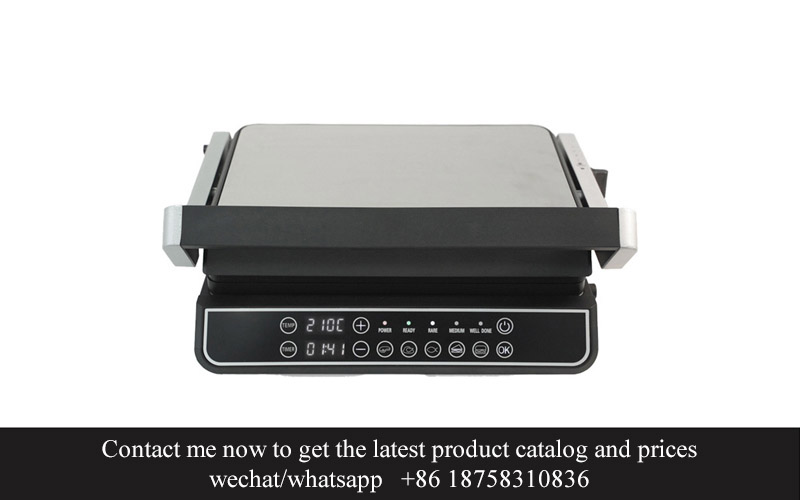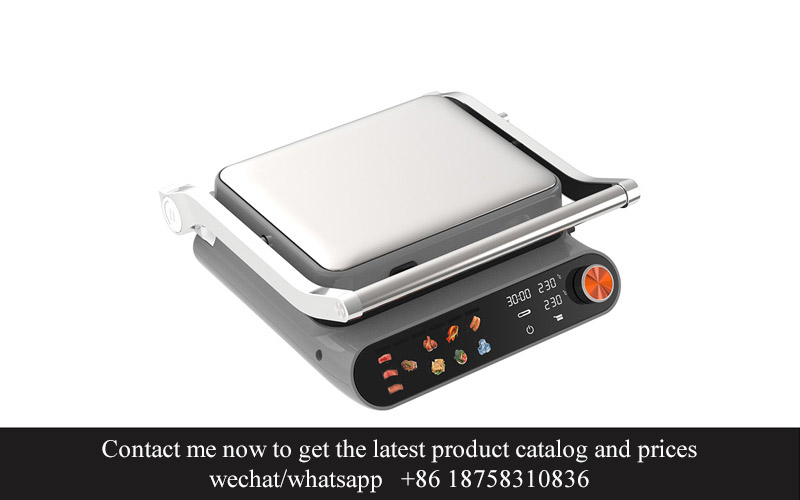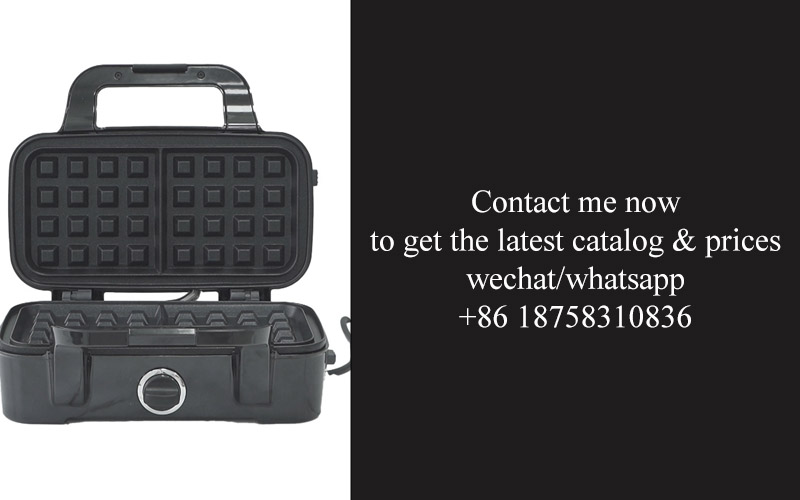Address
304 North Cardinal
St. Dorchester Center, MA 02124
Work Hours
Monday to Friday: 7AM - 7PM
Weekend: 10AM - 5PM
Address
304 North Cardinal
St. Dorchester Center, MA 02124
Work Hours
Monday to Friday: 7AM - 7PM
Weekend: 10AM - 5PM

In the ever-evolving landscape of kitchen appliances, innovation is the driving force behind the latest trends. As consumers seek convenience, efficiency, and style, the industry is responding with groundbreaking ideas and cutting-edge technology. This exploration delves into the realm of revolutionary kitchen appliances, the critical role of GOST R 50571.49-2019 certification, the latest industry trends, and the profound impact on both consumers and the market. It’s a journey that not only showcases the products of tomorrow but also the path we’re on to create a smarter, more sustainable kitchen.
The kitchen appliances market has experienced a remarkable transformation over the years, evolving from mere tools for daily cooking to integral components of modern living spaces. In the European and American markets, this sector has seen a surge in demand as consumers seek not only convenience but also innovation and sustainability.
As homes become more technologically advanced, kitchen appliances have stepped into the forefront of this evolution. Smart refrigerators, induction cooktops, and integrated ovens are just a few examples of how appliances have integrated advanced features that not only enhance cooking efficiency but also contribute to a more connected home ecosystem.
The market is driven by several key factors. Firstly, urbanization has led to smaller living spaces, where multifunctional appliances that save space are in high demand. Secondly, the rise of health consciousness has prompted a greater interest in appliances that can support healthier cooking methods, such as air fryers and slow cookers. Lastly, the integration of smart technology has opened up new avenues for appliance manufacturers to create products that offer personalized experiences and improved energy efficiency.
In Europe, the kitchen appliances market is characterized by a strong focus on design and quality. Brands like Siemens, Miele, and Bosh are renowned for their high-end products that cater to consumers who prioritize aesthetics and performance. Meanwhile, in the United States, the market is more diverse, with a wide range of brands offering everything from budget-friendly options to premium luxury appliances.
Consumer habits have also shifted significantly. The trend towards meal prepping and batch cooking has led to a demand for larger capacity appliances, while the popularity of healthy eating has spurred innovation in appliances that can bake, roast, and steam with minimal oil. Additionally, the increasing number of single-person households has created a niche for compact, energy-efficient appliances that are both functional and space-saving.
The competitive landscape is further complicated by the entry of tech giants into the kitchen appliances market. Companies like Google, Amazon, and Samsung are leveraging their expertise in software and connectivity to develop smart kitchen appliances that can be controlled through voice commands or smartphone apps. This convergence of technology and kitchenware has blurred the lines between consumer electronics and traditional appliances.
Despite the rapid advancements, there remain challenges in the market. Energy efficiency and environmental sustainability are paramount concerns, with regulations and consumer expectations both pushing manufacturers to produce appliances that are greener and more resourceful. Moreover, the integration of smart technology requires careful consideration to ensure user-friendliness and data security.
In the United States, for instance, the Energy Star program has been instrumental in setting standards for energy-efficient appliances, which are not only cost-effective for consumers but also environmentally friendly. Similarly, in Europe, the Ecodesign Directive aims to reduce the environmental impact of appliances by setting mandatory energy efficiency standards.
As the kitchen appliances market continues to grow and evolve, one certification that stands out is GOST R 50571.49-2019. This Russian standard is not only recognized in Europe and the United States but also serves as a benchmark for quality and safety. It ensures that products meet stringent requirements, providing consumers with confidence in the reliability and performance of their appliances.
In conclusion, the kitchen appliances market is a dynamic and rapidly changing sector. It is driven by innovation, consumer preferences, and environmental concerns. As manufacturers continue to push the boundaries of what is possible, the market will undoubtedly witness further advancements that not only improve the cooking experience but also contribute to a more sustainable future.

In the ever-evolving world of kitchen appliances, innovation is the driving force behind the latest trends that are reshaping the way we cook and live. From smart tech integration to sustainable design, here are some of the most innovative ideas currently making waves in the kitchen appliance market.
The integration of artificial intelligence (AI) and machine learning is revolutionizing the kitchen with appliances that can learn from your habits. Smart ovens and refrigerators, for instance, can adapt their settings based on your cooking preferences and dietary needs. This level of personalization ensures that your appliances work efficiently and effectively, providing a more tailored kitchen experience.
Energy efficiency is no longer just a buzzword; it’s a core feature in many of today’s appliances. Induction cooktops, for example, use magnetic fields to heat pots and pans directly, which is not only faster but also much more energy-efficient than traditional electric or gas burners. These advancements are not only reducing utility bills but also decreasing the carbon footprint of kitchen operations.
Designers are pushing the boundaries of what kitchen appliances can look like. Modern appliances are sleeker, with minimalist designs that blend seamlessly into the kitchen aesthetic. Integrated appliances that are concealed behind cabinet panels are becoming increasingly popular, as they offer a clean, uninterrupted look in the kitchen. The focus is on function and form, ensuring that your kitchen is as beautiful as it is practical.
In the realm of small appliances, there’s a surge in multifunctionality. Multicookers, for instance, combine the capabilities of a slow cooker, pressure cooker, rice cooker, and steamer into a single unit. This not only saves space but also simplifies meal preparation. Similarly, countertop ovens are now capable of air frying, toasting, and broiling, offering a variety of cooking methods with just one appliance.
Health and wellness are at the forefront of kitchen appliance innovation. Air fryers, which use hot air to circulate around food to achieve a crispy outer layer, have gained popularity as a healthier alternative to deep-frying. Moreover, the rise of sous-vide machines allows for precise temperature control, ensuring that food is cooked to perfection without overcooking or drying out.
Sustainability is a key driver behind the latest kitchen appliance designs. Manufacturers are increasingly using recycled materials in their products, and some appliances are even designed to be fully recyclable at the end of their life. The emphasis on sustainable materials and energy-efficient technology is a testament to the industry’s commitment to the environment.
The rise of smart kitchen systems is another significant trend. These systems, often controlled through smartphone apps, allow users to manage their appliances remotely. Imagine preheating your oven while on your way home or adjusting the fridge temperature to accommodate a last-minute grocery run. Smart kitchen systems enhance convenience and efficiency, making it easier to maintain the perfect kitchen environment.
Appliance connectivity is also becoming more sophisticated. Appliances can now communicate with each other, providing a cohesive and interconnected kitchen ecosystem. For example, a smart refrigerator can suggest recipes based on the ingredients you have, while your smart oven can be programmed to preheat just as your smart cooktop is ready to sear.
Finally, there’s a growing emphasis on customization. Many appliances now come with interchangeable parts and accessories, allowing users to tailor their kitchen tools to their specific needs. Whether it’s a specialized blade for your blender or a different set of attachments for your food processor, the options for personalization are expanding.
These innovative ideas in kitchen appliances are not just about convenience or style; they’re about changing the way we interact with our kitchens. By embracing technology, sustainability, and personalization, the kitchen appliance market is poised to transform our cooking experiences, making them more efficient, enjoyable, and in tune with our modern lifestyles.

In the rapidly evolving landscape of kitchen appliances, the pursuit of innovation is paramount. One key factor that stands out in this quest is the GOST R 50571.49-2019 certification. This standard, while not as widely recognized internationally as some others, holds significant weight in the European and American markets. It represents a commitment to quality, safety, and environmental responsibility that is increasingly becoming a hallmark of excellence in the industry.
The GOST R 50571.49-2019 certification is specifically designed for electrical household appliances, ensuring that they meet stringent safety and performance criteria. For manufacturers and consumers alike, this certification serves as a beacon of trust and reliability. It encompasses a wide range of appliances, from refrigerators and dishwashers to ovens and kitchen hoods, making it a comprehensive benchmark for the entire sector.
One of the primary reasons for the significance of GOST R 50571.49-2019 is its emphasis on safety. The certification process involves rigorous testing to ensure that appliances are free from hazards such as electric shock, fire, and overheating. This not only protects users from potential accidents but also extends the lifespan of the appliances, providing a more sustainable and cost-effective solution for consumers.
Moreover, the standard takes into account the environmental impact of kitchen appliances. It mandates the use of materials and manufacturing processes that are environmentally friendly, reducing waste and promoting recycling. This aspect of the certification is particularly important as consumers become more conscious of their ecological footprint and seek appliances that align with their values.
In terms of performance, GOST R 50571.49-2019 demands that appliances meet specific efficiency requirements. This means that certified appliances not only perform their intended functions effectively but also do so with minimal energy consumption. For manufacturers, this translates into the development of products that are not only user-friendly but also contribute to energy conservation, a critical factor in reducing utility bills and carbon emissions.
The certification also addresses the issue of user-friendliness. Appliances that carry the GOST R 50571.49-2019 mark are designed with the end-user in mind, featuring intuitive interfaces and user-friendly controls. This not only simplifies the cooking process but also enhances the overall kitchen experience, making appliances more accessible to a broader range of consumers, including those with disabilities.
For manufacturers, achieving GOST R 50571.49-2019 certification is no small feat. It requires a substantial investment in research and development, quality control, and compliance with the standard’s requirements. However, the benefits are substantial. Certified appliances can command premium prices in the market, as consumers are willing to pay for the assurance of quality and safety. This can lead to increased market share and brand recognition for companies that invest in this certification.
Furthermore, the certification process encourages innovation within the industry. Manufacturers are motivated to push the boundaries of what is possible in kitchen appliance design and technology. This drive for innovation has led to the creation of products that are not only more efficient and safer but also more aesthetically pleasing and functional. From smart kitchen systems that can be controlled via smartphone apps to appliances that adapt to the user’s cooking habits, the GOST R 50571.49-2019 certification has been a catalyst for groundbreaking advancements.
In the realm of international trade, the GOST R 50571.49-2019 certification also serves as a bridge between European and American markets and the Russian market. It allows manufacturers to export their products to Russia with the assurance that they meet local safety and quality standards, without the need for additional certifications. This can significantly simplify the export process and open up new markets for companies that are already compliant with the standard.
For consumers, the GOST R 50571.49-2019 certification is a powerful tool for making informed purchasing decisions. It provides a clear, recognizable mark of quality that can be easily identified on product packaging and in marketing materials. This transparency builds trust and allows consumers to make choices that align with their needs and values.
In conclusion, the GOST R 50571.49-2019 certification is a cornerstone of excellence in the kitchen appliance industry. It represents a commitment to safety, environmental responsibility, and performance that is increasingly valued by both manufacturers and consumers. As the demand for innovative and sustainable appliances grows, the significance of this certification is only likely to increase, shaping the future of kitchen technology and enhancing the lives of those who use these products every day.

The kitchen appliances industry is currently experiencing a wave of transformation, driven by evolving consumer needs and technological advancements. Here’s an exploration of the latest trends and data analysis shaping this dynamic sector:
Smart Integration and ConnectivityThe integration of smart technology into kitchen appliances has become increasingly prevalent. From refrigerators that can be controlled remotely to ovens that adjust cooking times based on recipes, smart appliances are becoming more connected than ever. Data analysis shows a significant rise in the adoption of smart kitchen devices, with consumers valuing the convenience and efficiency these innovations bring.
Sustainability and Energy EfficiencySustainability is at the forefront of kitchen appliance design. There’s a growing demand for energy-efficient models that reduce carbon footprints. According to recent studies, consumers are willing to pay a premium for appliances that offer eco-friendly features, such as LED lighting, programmable timers, and energy-saving modes. This shift is not only beneficial for the environment but also for users’ utility bills.
Health and Wellness FeaturesModern kitchen appliances are not just about convenience; they’re also about health and wellness. Food processors with pre-programmed healthy meal options, air fryers that offer healthier alternatives to traditional frying methods, and sous-vide cookers that ensure precise temperature control for safe and even cooking are becoming popular. Data indicates a surge in sales of such appliances, reflecting a health-conscious consumer base.
Customization and PersonalizationThe ability to customize kitchen appliances to individual preferences is another key trend. From customizable colors and finishes to appliances that can be controlled via personalized profiles, consumers are seeking products that reflect their unique tastes. Data from market research firms reveals a trend towards modular appliances and systems that can be expanded or adapted as needed.
Interactive and User-Friendly InterfacesAs technology advances, so does the need for user-friendly interfaces. Kitchen appliances with intuitive controls, clear displays, and voice-activated commands are becoming more common. This trend is driven by the desire for seamless integration of kitchen appliances into the home automation ecosystem. User experience data points to a preference for appliances that are as easy to operate as they are sophisticated in functionality.
Subscription-Based ServicesThe kitchen appliance industry is also embracing subscription-based models. This allows manufacturers to provide ongoing support, software updates, and even replacement parts as part of a service package. Data from industry reports suggests that this approach is gaining traction, particularly among younger consumers who are accustomed to subscription services for other aspects of their lives.
Health Monitoring and SafetyAppliances that monitor food safety and provide real-time alerts are becoming more sophisticated. Smart ovens and refrigerators can now detect spoilage, while smart ranges have safety features like flame failure detection. Data from appliance safety studies indicates that these features are becoming standard, reflecting a heightened awareness of food safety and safety in the kitchen.
The Role of Data AnalyticsData analytics is playing a crucial role in shaping the future of kitchen appliances. By analyzing consumer behavior, preferences, and usage patterns, manufacturers can tailor their products to meet specific needs. This data-driven approach is also enabling the development of predictive maintenance programs, which can help prevent appliance failures before they occur.
In summary, the latest industry trends in kitchen appliances are characterized by a blend of smart technology, sustainability, health-conscious features, customization, user-friendliness, subscription services, and enhanced safety. These trends are not only influenced by consumer demand but are also shaped by the data that drives innovation in the market.

In the realm of kitchen appliances, the latest innovations are not just limited to sleek designs but also to groundbreaking functionalities that enhance efficiency, convenience, and sustainability. Here are a few product examples that offer a glimpse into the future of kitchen technology:
The Smart Kitchen HubImagine a central control unit that seamlessly integrates with all your kitchen appliances. The Smart Kitchen Hub, equipped with advanced AI, learns your cooking habits and suggests recipes, adjusts cooking times, and optimizes energy use. It’s not just a gadget; it’s a personal chef and energy manager in one.
The Energy-Efficient RefrigeratorRefrigerators are a significant energy consumer in any kitchen. The latest models are engineered with cutting-edge insulation and smart cooling systems that adapt to the contents inside. They not only save energy but also use sensors to detect spoilage and alert you before your food goes bad.
The Induction Stove with Heat ManagementInduction cooktops have long been praised for their quick heating and energy efficiency. Now, with advanced heat management systems, they can maintain precise temperatures, ensuring that your dishes are cooked to perfection without wasting energy on unnecessary heat.
The Smart Oven with AI Cooking AssistanceThe smart oven has evolved to include AI capabilities that analyze the food’s composition and suggest cooking times and temperatures. It can even adjust its settings as the food cooks to ensure it’s done exactly right. The oven can also connect to your phone, allowing you to monitor and control it remotely.
The Modular Kitchen SystemThe future kitchen may not be a set of individual appliances but a modular system that can be customized to your needs. Imagine a kitchen where you can swap out a traditional oven for a convection microwave or add an extra countertop with a built-in spice grinder. It’s a kitchen that grows with you.
The Self-Cleaning Dishwasher with AIDishwashers are getting smarter, with AI-driven systems that can recognize the types of dishes and adjust the cleaning cycle accordingly. Some models now come with self-cleaning capabilities, using steam and high-pressure water jets to sanitize dishes without the need for chemicals.
The Integrated Waste Disposal SystemKitchen waste is a significant issue, but the latest waste disposal systems are designed to handle more than just food scraps. They can break down organic waste into nutrient-rich compost or even convert it into biogas. These systems are not only eco-friendly but also reduce the need for separate waste bins in the kitchen.
The Interactive Fridge with a TouchscreenGone are the days of a fridge just being a storage unit. Modern fridges now come with interactive screens that can display recipes, grocery lists, and even the weather forecast. They can also connect to your smart home system, allowing you to control other kitchen appliances or set reminders through the fridge’s interface.
The Solar-Powered Kitchen AppliancesWith the growing concern over climate change, solar-powered kitchen appliances are becoming more common. From solar ovens to solar-powered refrigerators, these eco-friendly devices harness renewable energy to reduce your carbon footprint.
The Voice-Controlled Kitchen AssistantVoice assistants have already revolutionized the way we interact with our devices, and now they’re making their way into the kitchen. With a simple voice command, you can turn on the coffee maker, preheat the oven, or start the washing machine. It’s a hands-free approach to kitchen management.
The Future isn’t just about having the latest gadgets; it’s about creating a kitchen environment that’s intuitive, efficient, and sustainable. These product examples are just a few steps on the journey to that future, where the kitchen is not just a place to cook but a hub of innovation and smart living.

In the ever-evolving landscape of kitchen appliances, consumers are increasingly seeking products that not only enhance their cooking experience but also cater to their desire for convenience, sustainability, and health. The benefits of these innovative appliances extend far beyond the kitchen, influencing the broader market and shaping consumer expectations.
The integration of smart technology has become a cornerstone in the kitchen appliance industry, offering users a level of connectivity and control that was once unimaginable. Smart ovens, for instance, can be remotely controlled via a smartphone app, allowing for meal preparation to begin before the user even arrives home. This level of personalization and efficiency is not just a convenience; it’s a game-changer for busy households and professionals alike.
Energy efficiency is another area where kitchen appliances have seen significant advancements. Modern refrigerators, dishwashers, and washing machines are designed with eco-friendly materials and energy-saving features that reduce utility bills and environmental impact. As consumers become more environmentally conscious, the demand for energy-efficient appliances has surged, driving manufacturers to innovate further.
Health and safety are paramount concerns in kitchen appliance design. Innovations such as touchless faucets and self-cleaning ovens have become popular, as they minimize the spread of germs and bacteria. Additionally, appliances with non-toxic coatings and BPA-free materials are gaining traction, reflecting a growing awareness of the importance of clean, safe cooking environments.
The market impact of these consumer benefits is profound. As appliances become more intelligent, they are also becoming more integrated into the home’s overall smart system. This integration not only streamlines daily tasks but also creates a seamless and interconnected living space. Consumers are willing to invest in these advanced appliances not only for their functionality but also for the added value they bring to their homes.
The rise of subscription services for kitchen appliances is another testament to the market’s responsiveness to consumer needs. Services that offer maintenance, repairs, and even the ability to swap out appliances for newer models as technology advances are becoming increasingly popular. This shift reflects a consumer preference for long-term relationships with brands, rather than one-time purchases.
Moreover, the impact of these products extends beyond the individual consumer. As appliance manufacturers focus on sustainability and energy efficiency, they are also contributing to broader environmental initiatives. The reduction in energy consumption and the use of recyclable materials are just a few ways in which the kitchen appliance industry is making a positive impact on the planet.
The market also benefits from the rise of health-conscious appliances. For example, slow cookers and air fryers have become popular due to their ability to prepare healthy meals with minimal oil and fat. This trend not only promotes a healthier lifestyle but also supports the growing demand for versatile appliances that can cater to a variety of dietary preferences and restrictions.
In conclusion, the benefits of innovative kitchen appliances are multifaceted. They enhance the consumer’s daily life, contribute to environmental sustainability, and drive market growth. As technology continues to advance, the kitchen appliance industry is poised to offer even more innovative solutions that cater to the evolving needs and expectations of consumers worldwide.

In the ever-evolving kitchen appliance industry, challenges and opportunities often go hand in hand. Navigating these complexities requires a keen eye for innovation and a willingness to adapt. Here’s a closer look at the hurdles and chances that shape the future of kitchen appliances.
The integration of smart technology presents a significant challenge for manufacturers. Ensuring that appliances are not only efficient but also user-friendly in an era of digital interconnectivity is no small feat. Compatibility issues and the rapid pace of technological advancements can make it difficult for companies to keep up, but it also opens doors to incredible opportunities.
For instance, the rise of the Internet of Things (IoT) has allowed appliances to become part of a larger network, offering a level of connectivity that was once unimaginable. This shift not only enhances the user experience but also presents new avenues for data collection and analysis, which can lead to more personalized and efficient products.
The sustainability movement has also emerged as a critical challenge and opportunity. Consumers are increasingly aware of the environmental impact of their appliances and are seeking eco-friendly options. This demand forces manufacturers to reconsider their supply chains and production methods, pushing them to innovate in areas like energy efficiency and recycling.
Energy-efficient appliances are not only more environmentally responsible but also cost-effective for consumers. The challenge lies in making these appliances affordable without compromising on quality. However, the opportunity is clear: as energy prices rise and environmental concerns grow, there’s a market for appliances that not only save energy but also save money in the long run.
Another challenge is the customization of products to cater to diverse consumer needs. With varying preferences and lifestyles, creating a one-size-fits-all solution is nearly impossible. This is where opportunities arise, as manufacturers can tap into the niche markets that cater to specific demographics. For example, the rise of health-conscious consumers has spurred the creation of appliances designed to improve diet and nutrition, such as sous-vide cookers and high-quality juicers.
The complexity of regulatory compliance adds another layer of challenge. Different regions have varying standards and certifications, making it challenging for companies to expand their markets. However, compliance also offers a chance to differentiate products and build trust with consumers. Appliances that meet or exceed the highest safety and quality standards can become a strong selling point in a competitive market.
Security concerns are also on the rise, particularly as smart appliances become more common. The potential for hacking and unauthorized access is a significant challenge, but it also presents an opportunity for manufacturers to invest in robust cybersecurity measures. By prioritizing security, companies can reassure customers and stay ahead of the curve in an increasingly digital world.
The global supply chain disruptions have been a harsh reality for many businesses, including those in the kitchen appliance industry. The challenge is to maintain product availability and affordability in the face of these disruptions. However, the opportunity lies in finding new suppliers, diversifying the supply chain, and fostering resilience. Companies that can navigate these challenges effectively will be better positioned to respond to future disruptions.
Lastly, the competition is fierce, with numerous players vying for market share. Standing out in this landscape requires constant innovation and a deep understanding of consumer trends. The opportunity here is to create a unique value proposition that resonates with customers, whether through exceptional design, superior functionality, or unparalleled customer service.
In conclusion, the kitchen appliance industry is brimming with challenges that demand creative solutions. From technological integration to sustainability, customization, and security, the road ahead is fraught with obstacles. However, these same challenges also present boundless opportunities for innovation and growth. As the industry continues to evolve, those who embrace these opportunities and rise to the challenges will undoubtedly shape the future of kitchen appliances.

In the ever-evolving landscape of kitchen appliances, the journey ahead is marked by a blend of challenges and opportunities that promise to redefine the way we interact with our kitchen spaces. As technology continues to advance, so does the demand for appliances that are not just functional but also innovative and sustainable. Here’s a glimpse into the multifaceted path forward.
The integration of smart technology in kitchen appliances is not just a trend; it’s a necessity. Consumers are increasingly seeking appliances that can be controlled remotely, offering convenience and efficiency. From smart refrigerators that can order groceries to ovens that can be preheated via a smartphone, the fusion of kitchen appliances with IoT (Internet of Things) is reshaping the market.
Energy efficiency remains a cornerstone of the industry. With rising energy costs and environmental concerns, manufacturers are under pressure to produce appliances that consume less power without compromising performance. The market is seeing a surge in energy-star-rated appliances, and the push for renewable energy sources in kitchen appliances is gaining momentum.
Customization is another key trend. Appliances that can be tailored to individual preferences and kitchen layouts are becoming more popular. From modular cooktops to customizable oven racks, the ability to personalize kitchen appliances is opening up new possibilities for homeowners.
Despite these advancements, there are challenges that the industry must navigate. The complexity of integrating smart features into existing appliances can lead to increased costs and potential malfunctions. Ensuring compatibility across various platforms and devices is a hurdle that manufacturers must overcome to maintain consumer satisfaction.
Regulatory compliance is another area of concern. As standards evolve, manufacturers must stay abreast of new regulations, such as GOST R 50571.49-2019, to ensure their products meet the necessary safety and quality benchmarks. This not only requires a significant investment in research and development but also in quality control processes.
On the flip side, there are numerous opportunities. The growing awareness of health and wellness is driving demand for appliances that can help consumers prepare healthier meals. This includes appliances with advanced cooking modes that preserve nutrients and reduce the need for unhealthy additives.
The rise of the gig economy and remote work is also creating new opportunities. Appliances that offer hands-free operation or can be controlled via voice commands are becoming more appealing to busy individuals who value efficiency and ease of use.
The market impact of these changes is profound. As consumers become more environmentally conscious, the demand for sustainable appliances is on the rise. This shift is not only influencing the design and production of kitchen appliances but also the supply chain and distribution channels.
Moreover, the global kitchen appliance market is witnessing a shift in consumer demographics. There is a growing segment of young, tech-savvy consumers who are driving innovation and expecting seamless integration of technology in their daily lives. This demographic is shaping the future of kitchen appliances, demanding products that are smart, connected, and user-friendly.
The industry must also adapt to changing consumer habits. The rise of meal kits and home delivery services has influenced how consumers think about kitchen appliances. There is a growing trend towards multi-functional appliances that can handle a variety of cooking tasks, from meal prep to cleanup.
In conclusion, the path forward in the kitchen appliance industry is complex but filled with promise. The convergence of technology, sustainability, and consumer needs is creating a landscape ripe for innovation. As manufacturers continue to push the boundaries of what’s possible, the future of the kitchen is sure to be a fascinating one, where appliances not only enhance our lives but also enrich them.